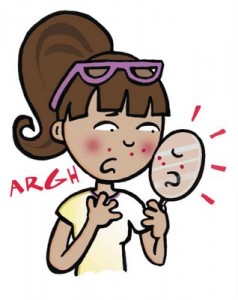 Any teenager can attest to how distressing a face full of acne is. Clear, unblemished skin is universally the number one and most important feature in attracting others. This basic law of attraction is because our skin is the largest component to our immune system – and healthy skin reflects a healthy body, which is required for reproducing.
Any teenager can attest to how distressing a face full of acne is. Clear, unblemished skin is universally the number one and most important feature in attracting others. This basic law of attraction is because our skin is the largest component to our immune system – and healthy skin reflects a healthy body, which is required for reproducing.
In the US, hundreds of millions of dollars are spent yearly on acne and blemish remedies and cover-ups. Our skin’s appearance is tied to our sex appeal and for most people being attractive to others is important.
In the 30 years I have been practicing Whole Health nutrition, working with young adolescents to clear up their skin problems and facilitate their sense of self-esteem and well-being, is one of the most rewarding experiences I’ve had in my practice. Educating teenagers about where and why acne develops provides them with the ability to make choices that can change the course of their outbreaks.
It all starts with androgens, which are reproductive hormones secreted into the blood stream by the productive organs and our stress adaptation system – our adrenal glands. Androgens are potent “chemicals” that our liver must deal with by reducing their potency.
The liver detoxifies the blood and when dealing with androgens, the liver produces blood plasma proteins which bind up and inactivate the majority of androgens, so that only a small percent of androgens are free to enter our cells.
During adolescence, the body is going through a huge hormonal change and all parts of the body needs time to adjust to and regulate hormone secretions. Because of the complex functions of hormones, a young body can become physically and even psychologically overwhelmed by the effect of androgens on the body functions and the brain.
How acne develops is when the androgens enter the cells, a specific enzyme converts the presenting androgens and makes them more active. The active androgens enter the nucleus of the cell and interacts with genetic material. This can lead to highly stimulated oil glands, and it is these highly stimulated oil glands that lead to the formation of acne.
Thee are several factors that determine the degree and amount of acne:
a) amount of androgens entering the cells
b) how well the liver controls the active androgens
c) the person’s nutrition and liver function
d) the amount of waste and/or toxins being re-absorbed into the liver from the bowel environment and – THIS IS THE KEY –
e) the amount of exercise the adolescent is doing that will utilize the androgens to build and create muscle tissue (rather than acne), thus reducing the amount of androgen that might be absorbed into the cells.
Especially in young males, but this applies to females as well, the fastest and easiest way to clear up adolescent acne, is have the person EXERCISE vigorously. Through the use of androgens by the body to build muscle rather than be available to interact with genetic material in the cell, rather quickly the androgens are re-directed to enhance strength and development rather than creating skin problems. The young patients and their parents think its a miracle, but its actually simple biochemistry.
In addition, healthy eating of lots of vegetables and fruits to keep the bowel clean, drinking plenty of water, skin hygiene and proper amounts of sleep, all help the liver, bowel and adrenals to function properly, which supports an overall healthy body with resultant glowing, attractive skin.
The expression “it’s more than skin deep” clearly applies to acne and skin blemishes. You may want to share this information with someone having acne issues because if they use it – they will see a difference.
With all good wishes,
G
Copyright 2011 G. Donadio All Rights Reserved








